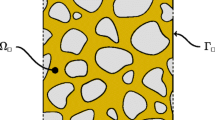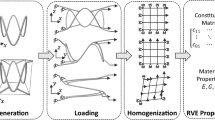Abstract
The goal of computational homogenization is to obtain the macro-scale response, normally in terms of macro-scale stress for given macro-scale deformation, via RVE-computations. In this paper we investigate, in a systematic manner, the effects of Dirichlet and Neumann boundary conditions on the RVE. Adaptive computations are carried out with respect to, in particular, control of the error in the macro-scale stress tensor. This requires the corresponding dual solutions. As a new result, it is shown how the same dual solutions can be conveniently used in computing the algorithmic tangent stiffness tensor, thereby demonstrating the “power of duality”.
Similar content being viewed by others
References
Aubry S, Fago M, Ortiz M (2003) A constrained sequential-lamination algorithm for the simulation of sub-grid microstructure in martensitic materials. Comput Methods Appl Mech Eng 192:2823–2843
Braack M, Ern A (2003) A posteriori control of modeling errors and discretization errors. Multiscale Model Simul 1:221–238
Becker R, Rannacher R (1996) A feed-back approach to error control in finite element methods: basic analysis and examples. East-West J Numer Math 4:237–264
Eriksson K, Estep D, Hansbo P, Johnson C (1995) Introduction to adaptive methods for differential equations. Acta Numer 105–158
Kouznetsova V, Geers MGD, Brekelmans WAM (2002) Multi-scale constitutive modelling of heterogeneous materials with a gradient-enhanced computational homogenization scheme. Int J Numer Methods Eng 54:1235–1260
Larsson F, Runesson K (2004) Modeling and discretization errors in hyperelasto-(visco-)plasticity with a view to hierarchical modeling. Comput Methods Appl Mech Eng 193:5283–5300
Larsson F, Runesson K (2004) Error controlled meso–macro-scale material modeling and computation. In: Proccedings of 4th European congress on computational methods in applied sciences and engineering
Larsson F, Runesson K (2004) Meso–macro-scale constitutive modeling with error control. In: Proceedings CDROM of the sixth world congress on computational mechanics in conjunction with the second asian-pacific congress on computational mechanics
Larsson F, Hansbo P, Runesson K (2002) Strategies for computing goal-oriented a posteriori error measures in nonlinear elasticity. Int J. Numeri Methods Eng 55:879–894
Löhnert S, Wriggers P, (2003) Homogenisation of microheterogeneous materials considering interfacial delamination at finite strains. Technische Mechanik 23:167–177
Miehe C, Koch A, (2002) Computational micro-to-macro transitions of discretized microstructures undergoing small strains. Arch Appl Mech 72:300–317
Miehe C, Schröder J, Schotte J (1999) Computational homogenization analysis in finite plasticity simulation of texture development in polycrystalline materials. Comput Methods Appl Mech Eng 171:387–418
Oden JT, Vemaganti KS (2000) Estimation of local modeling error and goal-oriented adaptive modeling of heterogeneous materials. J Comput Phys 164:22–47
Oden JT (2002) A posteriori estimation of modeling and approximation error in computational science and engineering: new tools for verification and validation of computer simulations. In: Proceedings of fifth world congress on computational mechanics
Oden JT, Prudhomme S, Hammerand DC, Kuczma MS (2001) Modeling error and adaptiveity in nonlinear continuum mechanics. Comput Methods App Mech Eng 190:6663–6684
Stein E, Ohnimus S (1997) Coupled model- and solution-adaptivity in the finite-element method. Comput Methods Appl Mech Eng 150:327–350
Stein E, Ohnimus S (1999) Anisotropic discretization- and model-error estimation in solid mechanics by local Neumann problems. Comput Methods App Mech Eng 176:363–385
Stein E, Ohnimus S, Rüter M (2001) Hierarchical model- and discretization-error estimation of elasto-plastic structures. In: Aref H, Philips JW (eds) Mechanics for a new millenium. Kluwer Dordrecht
Zohdi TI, Wriggers P (2005) Introduction to computational micromechanics. Springer, Berlin Heidelberg New York
Author information
Authors and Affiliations
Corresponding author
Rights and permissions
About this article
Cite this article
Larsson, F., Runesson, K. RVE computations with error control and adaptivity: the power of duality. Comput Mech 39, 647–661 (2007). https://doi.org/10.1007/s00466-006-0108-z
Received:
Accepted:
Published:
Issue Date:
DOI: https://doi.org/10.1007/s00466-006-0108-z




